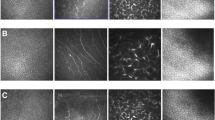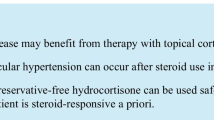Abstract
Introduction
To compare the effects of a preservative-free (PF) ophthalmic solution containing hyaluronic acid (HA) 0.4% and taurine (TAU) 0.5% with those of a PF ophthalmic solution containing HA 0.2% on ocular surface signs, symptoms, and morphological parameters in glaucoma patients under multiple long-term topical hypotensive therapy.
Methods
Eligible patients underwent evaluation of ocular surface parameters by ocular surface disease index (OSDI) and glaucoma symptom scale (GSS) questionnaires, breakup time test (BUT), Schirmer I test, corneal and conjunctival staining (Oxford scale), and conjunctival in vivo confocal microscopy (Heidelberg Retina Tomograph 3, Heidelberg Engineering GmbH, Heidelberg, Germany). After the baseline visit, patients were randomized to use a PF ophthalmic solution containing HA 0.4% and TAU 0.5%, QID, in both eyes (group 1) or to use a PF ophthalmic solution containing HA 0.2%, QID (group 2) in addition to the ongoing preserved hypotensive treatment. Follow-up visits were scheduled at 30 and 90 days.
Results
Thirty-nine eyes of 39 glaucoma patients were included in the study. At baseline, results of study tests of both groups were similar. After 90 days in group 1 the BUT (p = 0.01), the Oxford score (p = 0.03), the conjunctival goblet cells (CGC) density (p = 0.0005) ,and the two questionnaires score significantly improved (OSDI, p = 0.003; GSS, p = 0.003) compared to baseline values, while in group 2 all these parameters did not differ from baseline (BUT, p = 0.39; Oxford score, p = 0.54; CGC density, p = 0.33, OSDI p = 0.65, GSS, p = 0.25). The BUT and the CGC density were statistically different between groups both at 30 and 90 days (p = 0.04 and p = 0.04, respectively). The Schirmer I test did not statistically change after 90 days in both groups.
Conclusions
The PF ophthalmic solution with HA 0.4% and TAU 0.5% seems to improve CGC density and reduce signs and symptoms of dry eye in glaucoma patients under long-term multiple preserved hypotensive therapy.
Trial registration
ClinicalTrials.gov identifier, NCT03480295.
Similar content being viewed by others
References
De Moraes CG, Demirel S, Gardiner SK, et al. Effect of treatment on the rate of visual field change in the ocular hypertension treatment study observation group. Invest Ophthalmol Vis Sci. 2012;53:1704–9.
Leske MC, Heijl A, Hussein M, et al. Factors for glaucoma progression and the effect of treatment. Arch Ophthalmol. 2003;121:48–56.
Lichter PR, Musch DC, Gillespie BW, et al. Interim clinical outcomes in the Collaborative Initial Glaucoma Treatment Study comparing initial treatment randomized to medications or surgery. Ophthalmology. 2001;108:1943–53.
European Glaucoma Society. Terminology and guidelines for glaucoma. 4th ed. Savona, Italy: Publicomm; 2014.
Rossi GC, Pasinetti GM, Scudeller L, Bianchi PE. Ocular surface disease and glaucoma: how to evaluate impact on quality of life. J Ocul Pharmacol Ther. 2013;29(4):390–4.
Ghosh S, O’Hare F, Lamoureux E, Vajpayee RB, Crowston JG. Prevalence of signs and symptoms of ocular surface disease in individuals treated and not treated with glaucoma medication. Clin Exp Ophthalmol. 2012;40:675–81.
Skalicky SE, Goldberg I, McCluskey P. Ocular surface disease and quality of life in patients with glaucoma. Am J Ophthalmol. 2012;153:1–9.
Pisella PJ, Pouliquen P, Baudouin C. Prevalence of ocular symptoms and signs with preserved and preservative free glaucoma medication. Br J Ophthalmol. 2002;86:418–23.
Gomes JAP, Azar DT, Baudouin C, et al. TFOS DEWS II iatrogenic report. Ocul Surf. 2017;15:511–38.
Aragona P, Papa V, Micali A, Santocono M, Milazzo G. Long term treatment with sodium hyaluronate-containing artificial tears reduces ocular surface damage in patients with dry eye. Br J Ophthalmol. 2002;86:181–4.
Johnson ME, Murphy PJ, Boulton M. Effectiveness of sodium hyaluronate eyedrops in the treatment of dry eye. Graefes Arch Clin Exp Ophthalnol. 2006;244:109–12.
Troiano P, Monaco G. Effect of hypotonic 0.4% hyaluronic acid drops in dry eye patients: a cross-over study. Cornea. 2008;27:1126–30.
Pinto-Fraga J, López-de la Rosa A, Blázquez Arauzo F, Urbano Rodríguez R, González-García MJ. Efficacy and safety of 0.2% hyaluronic acid in the management of dry eye disease. Eye Contact Lens. 2017;43:57–63.
Nakamori K, Koyama I, Nakamura T, Nemoto M, Yoshida T, Umeda M, Inoue K. Quantitative evaluation of the effectiveness of taurine in protecting the ocular surface against oxidant. Chem Pharm Bull. 1993;41:335–8.
ChenZhuo L, Murube J, Latorre A, del Rio RM. Different concentrations of amino acids in tears of normal and human dry eyes. Adv Exp Med Biol. 2002;506:617–21.
Pasantes-Morales H, Wright CE, Gaull GE. Taurine protection of lymphoblastoid cells from iron-ascorbate induced damage. Biochem Pharmacol. 1985;34:2205–7.
Nakatsukasa M, Sotozono C, Shimbo K, et al. Amino acid profiles in human tear fluids analyzed by high-performance liquid chromatography and electrospray ionization tandem mass spectrometry. Am J Ophthalmol. 2011;151:799–808.
Rusciano D, Roszkowska AM, Gagliano C, Pezzino S. Free amino acids: an innovative treatment for ocular surface disase. Eur J Pharmacol. 2016;787:9–19.
Schiffman RM, Christianson MD, Jacobsen G, Hirsch JD, Reis BL. Reliability and validity of the ocular surface disease index. Arch Ophthalmol. 2000;118:615–21.
Lee BL, Gutierrez P, Gordon M, et al. The glaucoma symptom scale. A brief index of glaucoma-specific symptoms. Arch Ophthalmol. 1998;116:861–6.
Rossi GCM, Pasinetti GM, Scudeller L, et al. The Italian version of the glaucoma symptom scale questionnaire: translation, validation, and reliability. J Glaucoma. 2013;22:44–51.
Bron A, Evans VE, Smith JA. Grading of corneal and conjunctival staining in the context of other dry eye tests. Cornea. 2003;22:640–50.
Mastropasqua L, Agnifili L, Fasanella V, et al. Conjunctival goblet cells density and preservative-free tafluprost therapy for glaucoma: an in vivo confocal microscopy and impression cytology study. Acta Ophthalmol. 2013;91:397–405.
Zhu W, Zhu W, Kong X, Xu J, Sun X. Effects of long-term antiglaucoma eye drops on conjunctival structures: an in vivo confocal microscopy study. J Ophthalmol. 2015;165475.
Doughty MJ, Bergmanson JP. New insights into the surface cells and glands of the conjunctiva and their relevance to the tearfilm. Optometry. 2003;74:485–500.
Agnifili L, Fasanella V, Mastropasqua R, et al. In vivo goblet cell density as a potential indicator of glaucoma filtration surgery outcome. Invest Ophthalmol Vis Sci. 2016;57:2898–905.
Nishida T, Nakamura M, Mishima H, Otori T. Hyaluronan stimulates corneal epithelial migration. Exp Eye Res. 1991;53:753–8.
Jong CJ, Azuma J, Schaffer S. Mechanism underlying the antioxidant activity of taurine: prevention of mitochondrial oxidant production. Amino Acids. 2012;42:2223–32.
Acknowledgements
We thank the participants of the study.
Funding
The research for this paper was supported by the Italian Ministry of Health and by Fondazione Roma. No funding or sponsorship was received for the publication of this article.
Authorship
All named authors meet the International Committee of Medical Journal Editors (ICMJE) criteria for authorship for this article, take responsibility for the integrity of the work, and have given their approval for this version to be published.
Disclosures
Gloria Roberti, Luca Agnifili, Francesca Berardo, Ivano Riva, Michele Figus, Gianluca Manni, Luciano Quaranta, and Francesco Oddone have nothing to disclose.
Compliance with Ethics Guidelines
All procedures performed in studies involving human participants were in accordance with the ethical standards of the institutional committee (IRCCS Fondazione G.B. Bietti, Trial Registry N.51/FB/16) and with the 1964 Declaration of Helsinki and its later amendments or comparable ethical standards. Informed consent was obtained from all individual participants included in the study.
Data availability
The data sets generated and/or analyzed during the current study are available from the corresponding author on reasonable request.
Author information
Authors and Affiliations
Corresponding author
Additional information
Enhanced digital features
To view enhanced digital features for this article go to https://doi.org/10.6084/m9.figshare.6120980.
Rights and permissions
About this article
Cite this article
Roberti, G., Agnifili, L., Berardo, F. et al. Prospective, Randomized, Single Masked, Parallel Study Exploring the Effects of a Preservative-Free Ophthalmic Solution Containing Hyaluronic Acid 0.4% and Taurine 0.5% on the Ocular Surface of Glaucoma Patients Under Multiple Long-Term Topical Hypotensive Therapy. Adv Ther 35, 686–696 (2018). https://doi.org/10.1007/s12325-018-0699-8
Received:
Published:
Issue Date:
DOI: https://doi.org/10.1007/s12325-018-0699-8




